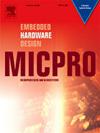Implementation and characterization of a fault-tolerant CCSDS 123 hardware accelerator under neutron radiation
IF 2.6
4区 计算机科学
Q3 COMPUTER SCIENCE, HARDWARE & ARCHITECTURE
引用次数: 0
Abstract
In space applications, remote sensing relies on HSIs (Hyperspectral Images) to capture extensive Earth observation data. However, the substantial data volumes generated by HSIs present significant challenges for onboard storage and processing in space systems, underscoring the importance of efficient compression strategies. Additionally, the harsh conditions of the space environment expose these systems to potential faults, making the integration of fault-tolerant mechanisms crucial for maintaining reliable operation. In this context, this article presents the implementation of a low-cost and fault-tolerant CCSDS 123 HSI compressor. The compressor is present in different configurations employing hardening techniques such as TMR (Triple Modular Redundancy) and Hamming ECC (Error Correcting Code) to mitigate SEUs (Single-Event Upsets). We implemented techniques to enhance observability and evaluated the compressor reliability through fault injection simulations and physical tests at the ChipIr neutron irradiation facility. We present the resource utilization and performance results of each version with a comparative analysis with related work. The results highlight the lowest resource utilization achieved in the unhardened version, capable of processing 20.57 MSa/s and accelerating the application in 24 compared to a software solution. The reliability results demonstrate a high error rate of 97.9% in the unhardened version, significantly reduced in partially hardened versions, with no error propagation in the fully hardened design. Furthermore, we present an analysis of the main components of the accelerator affected by the radiation-induced events observed in the particle accelerator test.
中子辐射容错CCSDS 123硬件加速器的实现与特性研究
在空间应用中,遥感依靠高光谱图像(hsi)来获取广泛的地球观测数据。然而,hsi产生的大量数据量对空间系统的机载存储和处理提出了重大挑战,强调了有效压缩策略的重要性。此外,空间环境的恶劣条件使这些系统暴露于潜在故障,使得容错机制的集成对于保持可靠运行至关重要。在这种情况下,本文介绍了一种低成本、容错的CCSDS 123 HSI压缩机的实现。压缩机采用不同的配置,采用强化技术,如TMR(三模冗余)和Hamming ECC(纠错码),以减轻SEUs(单事件故障)。通过故障注入模拟和ChipIr中子辐照设施的物理测试,我们实施了增强可观测性的技术,并评估了压缩机的可靠性。我们给出了每个版本的资源利用率和性能结果,并与相关工作进行了比较分析。结果显示,未加固版本的资源利用率最低,处理速度为20.57 MSa/s,与软件解决方案相比,应用程序的速度提高了24倍。可靠性结果表明,在未硬化版本中错误率高达97.9%,在部分硬化版本中显著降低,在完全硬化设计中没有错误传播。此外,我们还分析了粒子加速器试验中观测到的辐射诱导事件对加速器主要部件的影响。
本文章由计算机程序翻译,如有差异,请以英文原文为准。
求助全文
约1分钟内获得全文
求助全文
来源期刊

Microprocessors and Microsystems
工程技术-工程:电子与电气
CiteScore
6.90
自引率
3.80%
发文量
204
审稿时长
172 days
期刊介绍:
Microprocessors and Microsystems: Embedded Hardware Design (MICPRO) is a journal covering all design and architectural aspects related to embedded systems hardware. This includes different embedded system hardware platforms ranging from custom hardware via reconfigurable systems and application specific processors to general purpose embedded processors. Special emphasis is put on novel complex embedded architectures, such as systems on chip (SoC), systems on a programmable/reconfigurable chip (SoPC) and multi-processor systems on a chip (MPSoC), as well as, their memory and communication methods and structures, such as network-on-chip (NoC).
Design automation of such systems including methodologies, techniques, flows and tools for their design, as well as, novel designs of hardware components fall within the scope of this journal. Novel cyber-physical applications that use embedded systems are also central in this journal. While software is not in the main focus of this journal, methods of hardware/software co-design, as well as, application restructuring and mapping to embedded hardware platforms, that consider interplay between software and hardware components with emphasis on hardware, are also in the journal scope.
 求助内容:
求助内容: 应助结果提醒方式:
应助结果提醒方式:


